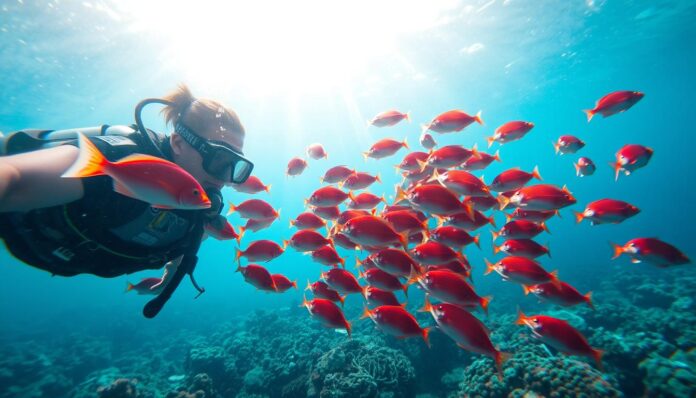Did you know that snappers can form schools of thousands? They turn underwater landscapes into breathtaking living canvases. Scuba diving with snappers offers a unique peek into marine ecosystems.
Dive into the mesmerizing world of underwater exploration. Scuba diving with snappers becomes an unforgettable adventure. Our guide will unlock the secrets of these fascinating fish species, revealing the magic beneath the waves.
From understanding snapper behavior to discovering the most incredible diving locations, this guide promises to transform your underwater experience. Whether you’re a beginner or seasoned diver, get ready for an immersive journey into the realm of snappers.
Key Takeaways – Diving with Snappers
- Snappers thrive in diverse marine environments worldwide
- Scuba diving allows close encounters with unique marine ecosystems
- Understanding snapper fish species enhances diving experiences
- Proper equipment and techniques are key for safe diving
- Conservation is vital in protecting marine habitats
What Are Snappers?
Snappers are fascinating marine creatures that attract divers and marine lovers everywhere. They belong to the Lutjanidae family and have over 100 species. Each species has its own special traits, making fish identification guides key for underwater explorers.
These marine wonders live in tropical and subtropical waters. They vary greatly in size, color, and behavior. Some snappers can grow up to three feet long. The biggest, the cubera snapper, can reach five feet and weigh up to 130 pounds.
Understanding Snapper Species
Snappers show amazing diversity in different marine settings. Some important species include:
- Bohar snapper: Most abundant mid-sized reef dweller in Indonesia
- Malabar snapper: Crucial in commercial fisheries
- Goldband snapper: Deep-water specialist
- Flame snapper: Known for its bright red color
Importance in the Ecosystem
Snappers are vital in marine ecosystems as mid-level predators. Their social behavior and hunting strategies help maintain underwater biodiversity. They mainly eat:
- Smaller fish
- Crustaceans
- Cephalopods
| Snapper Species | Current Biomass | Typical Habitat |
|---|---|---|
| Malabar Snapper | 13% of pristine levels | Sandy bottoms up to 100m |
| Goldband Snapper | 16% of pristine levels | Depths over 200m |
| Flame Snapper | 7% of pristine levels | Deep offshore waters |
“Snappers are not just fish; they are essential guardians of marine ecosystem balance.” – Marine Ecology Research Institute
Learning about these amazing snapper fish species through detailed fish identification guides is vital. It helps marine enthusiasts understand their importance and support conservation efforts.
Best Locations for Scuba Diving with Snappers
Diving fans looking for amazing underwater adventures will love the snappers in the world’s most stunning marine spots. The Caribbean is a top place to see these fish in their home.
Caribbean Hotspots for Snapper Encounters
The Caribbean is full of incredible places to see snappers. Here are some of the best spots:
- Cayman Islands: Wall dives with lots of snappers
- Cozumel: Colorful reefs with many snapper species
- Bonaire: Marine areas protected for over 35 years
In the Cayman Islands, you can dive at depths perfect for spotting snappers. The Winch Hole dive site, at 8 meters (25 feet), is great for exploring underwater.
Popular Pacific Diving Sites
The Pacific has amazing marine worlds where snappers live:
- Great Barrier Reef: Famous for its marine life
- Raja Ampat: Unique underwater landscapes
- Philippines Coral Triangle: Home to 75% of the world’s coral species
“The ocean is a magical world where snappers dance through coral landscapes, revealing nature’s most delicate performances.” – Marine Exploration Journal
Best Destinations for Diving with Snappers
Diving with snappers is an incredible experience that can be enjoyed in various locations across the globe. From the warm waters of the Caribbean to the stunning coral reefs of Oceania, there are numerous destinations that offer memorable encounters with these captivating fish. Let’s explore some of the best diving destinations for encountering snappers, categorized by regions:
Asia:
- Maldives: Known for its pristine coral reefs and abundant marine life, the Maldives offers excellent opportunities for diving with snappers. Explore the atolls and channels to witness large schools of snappers thriving in their natural habitat.
- Indonesia: With its vast archipelago, Indonesia boasts diverse dive sites teeming with marine life. Destinations like Raja Ampat, Komodo National Park, and Bunaken National Park provide incredible encounters with snappers amidst vibrant coral gardens.
- Egypt: The Red Sea in Egypt is renowned for its crystal-clear waters and vibrant reefs. Destinations like Sharm El Sheikh, Hurghada, and Dahab offer diverse dive sites where snappers can be found alongside other fascinating marine species.
- Mozambique: The warm waters of Mozambique are home to an array of marine life, including snappers. Explore destinations such as the Bazaruto Archipelago or Tofo Beach for unforgettable encounters with these captivating fish.
Caribbean:
- Belize: With its barrier reef system, Belize offers exceptional diving opportunities. Dive sites like the Blue Hole and Turneffe Atoll are known for their snapper populations, providing thrilling encounters with schools of these fish.
- Bonaire: Known as a diver’s paradise, Bonaire in the Dutch Caribbean is home to vibrant coral reefs and abundant marine life. Snappers can be spotted along the drop-offs and reef walls, making it an ideal destination for diving enthusiasts.
- Costa Rica: The Pacific coast of Costa Rica offers exciting diving opportunities with snappers. Destinations like Cocos Island and Cano Island are renowned for their marine biodiversity and encounters with large schools of fish.
- Honduras: The Bay Islands of Honduras, including Roatán and Utila, are known for their stunning dive sites. Snappers can be found in the vibrant reefs surrounding these islands, creating unforgettable underwater experiences.
- Red Sea (Egypt and Jordan): While part of the Red Sea falls under Africa, the region’s accessibility from Europe makes it an attractive diving destination. Egypt’s Red Sea coast and Jordan’s Aqaba offer superb diving opportunities to encounter snappers and explore breathtaking reefs.
Oceania:
- Great Barrier Reef (Australia): The Great Barrier Reef needs no introduction. This iconic destination is home to a vast array of marine life, including snappers. Dive along the reef’s pristine sections to witness the beauty and diversity of these fish.
- Fiji: With its warm waters and stunning coral reefs, Fiji is a haven for divers. Explore sites like the Bligh Waters and the Somosomo Strait to encounter snappers amid the vibrant marine ecosystem.
- Florida Keys (USA): The Florida Keys offer excellent diving opportunities with snappers. Explore the coral reefs along the keys, such as John Pennekamp Coral Reef State Park and Looe Key, for encounters with these colorful fish.
- Galápagos Islands (Ecuador): The Galápagos Islands are renowned for their unique marine biodiversity. Dive among the volcanic seascapes to encounter snappers, alongside other iconic species like marine iguanas and hammerhead sharks.
- Cozumel (Mexico): Cozumel’s clear turquoise waters and vibrant reefs make it a popular destination for divers. Snappers can be found throughout the dive sites, providing thrilling encounters for underwater enthusiasts.
These destinations offer incredible opportunities to dive with snappers, each providing a unique experience and a chance to witness the beauty of these captivating fish in their natural habitats.
Remember to research the best time to visit each destination, considering factors such as water temperature, visibility, and the snapper species prevalent in the area. Dive responsibly, adhere to local regulations, and respect the marine environment to ensure the conservation of these precious underwater ecosystems.
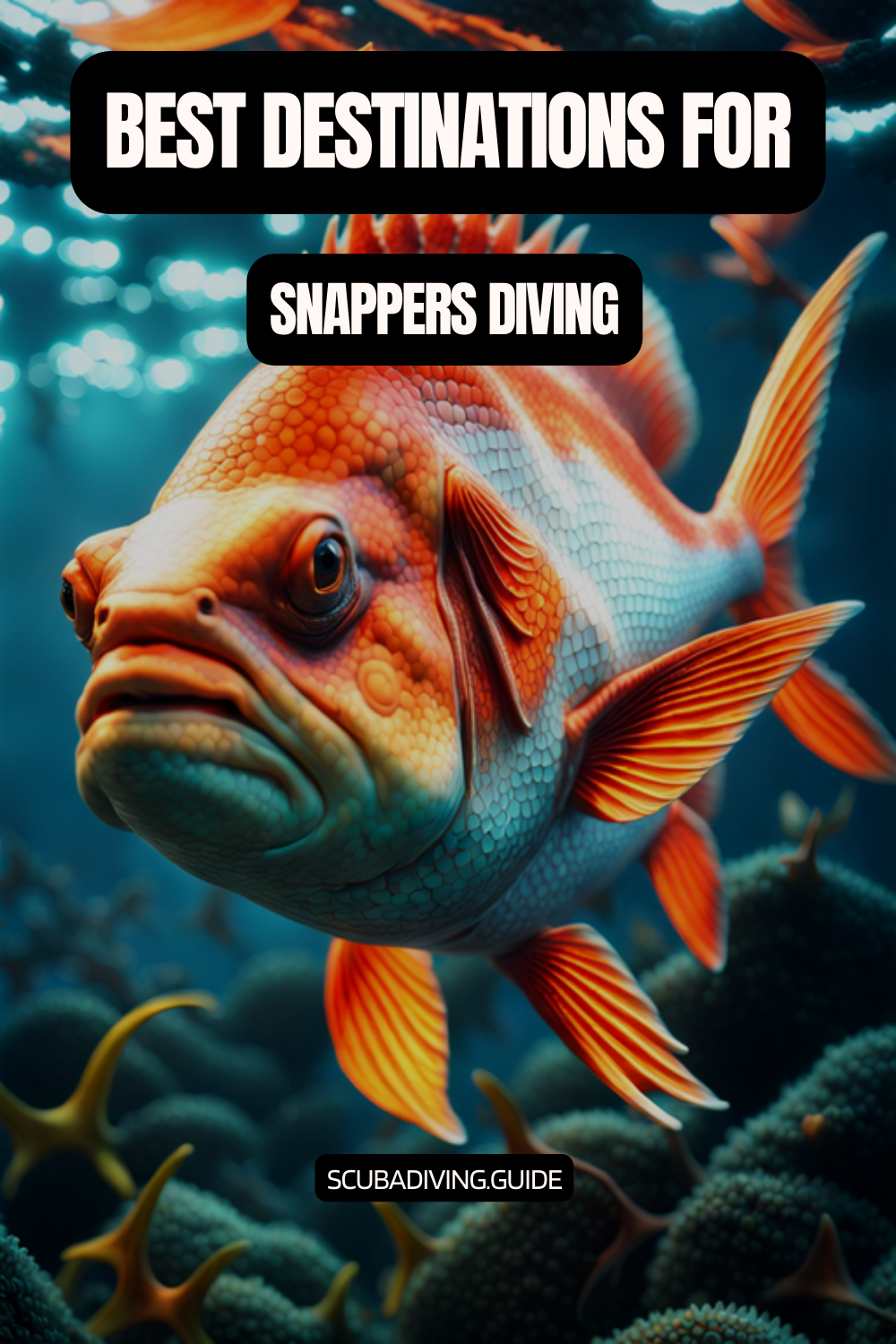
Hidden Diving Gems
For those who love unique dives, check out these hidden spots:
- Roatán’s West End Wall: Depths from 6-18 meters
- Hanifaru Bay: Amazing marine diversity
- Abu Dabbab: Depths between 9-18 meters
February is the best time for diving in the Caribbean. It’s when the conditions are perfect for seeing snappers up close. Each place offers a special chance to see these amazing fish in their natural home.
Ideal Conditions for Scuba Diving with Snappers
Diving with snappers needs careful thought about the environment. Knowing the best underwater spots can make your dive unforgettable.
Water Temperature and Visibility
Scuba diving with snappers works best in certain water conditions. The best temperature for these fish is between 75-85°F (24-29°C). Good visibility is key to see snapper habitats and behavior.
- Recommended water temperature: 75-85°F
- Minimum visibility: 20 feet (6 meters)
- Best depth range: 10-40 meters
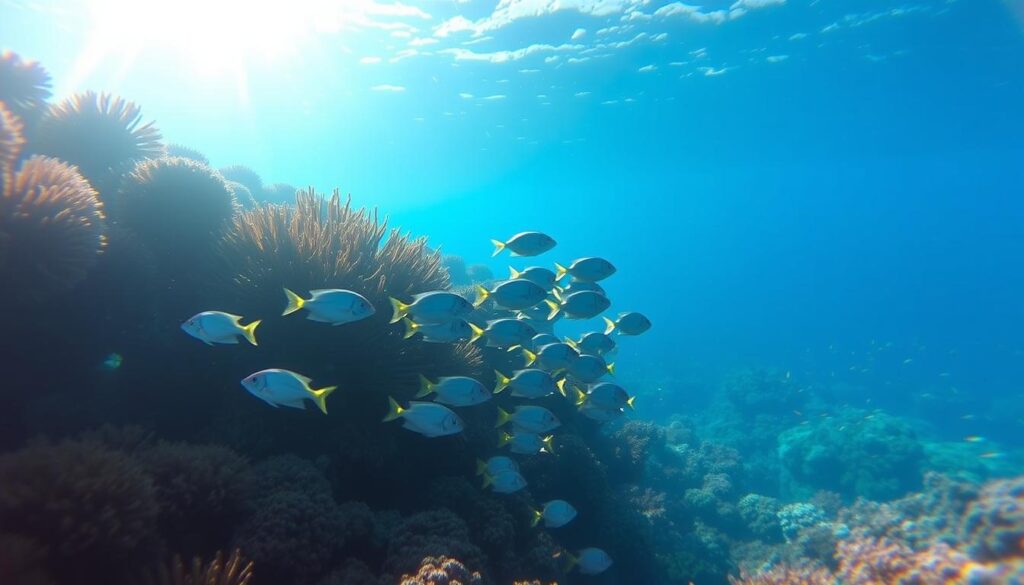
Best Seasons to Dive
Snappers have unique behaviors all year. Knowing when they move can make your dive better.
| Region | Best Diving Months | Water Conditions |
|---|---|---|
| Caribbean | December-April | Warm, Clear |
| Pacific | May-September | Stable, High Visibility |
| Indo-Pacific | Year-round | Consistent Conditions |
“The secret to an exceptional snapper dive lies in understanding their natural environment and timing.” – Marine Exploration Expert
Experts say to check local marine reports and talk to dive guides. This can help you see amazing snappers.
What to Expect During Snorkeling with Snappers
Snorkeling with snappers is an exciting adventure that will amaze you. It lets you see the colorful world of these fish up close. You’ll learn about their social lives and behaviors.
Learning about snappers’ swim patterns can make your snorkeling trip unforgettable. These fish, known as Macolor niger, have traits that make their encounters special.
Swim Patterns and Social Behavior
Snappers live in complex societies, making snorkeling with them fun. You’ll see them:
- Swimming in tight schools for protection
- Navigating around coral reefs and rocky outcrops
- Displaying synchronized movement patterns
- Hunting in coordinated groups
Marine Life Interactions
Snorkeling with snappers means seeing them interact with other sea creatures. You’ll see interesting moments with:
| Marine Species | Interaction Type |
|---|---|
| Sea Turtles | Shared habitat proximity |
| Fusiliers | Collaborative hunting |
| Lionfish | Territorial coexistence |
| Scorpionfish | Camouflage competition |
“The underwater world of snappers is a complex dance of survival, beauty, and unexpected interactions.” – Marine Biologist
Snappers are skilled hunters. You might see them quickly moving between rocks. This shows their agility and smarts.
Gear Up: Essential Equipment for Scuba Diving
Getting ready for scuba diving with snappers means picking the right gear. The right equipment is key for a safe and fun dive. It doesn’t matter if you’re new or have lots of dives under your belt. Knowing what you need is important for a great time.
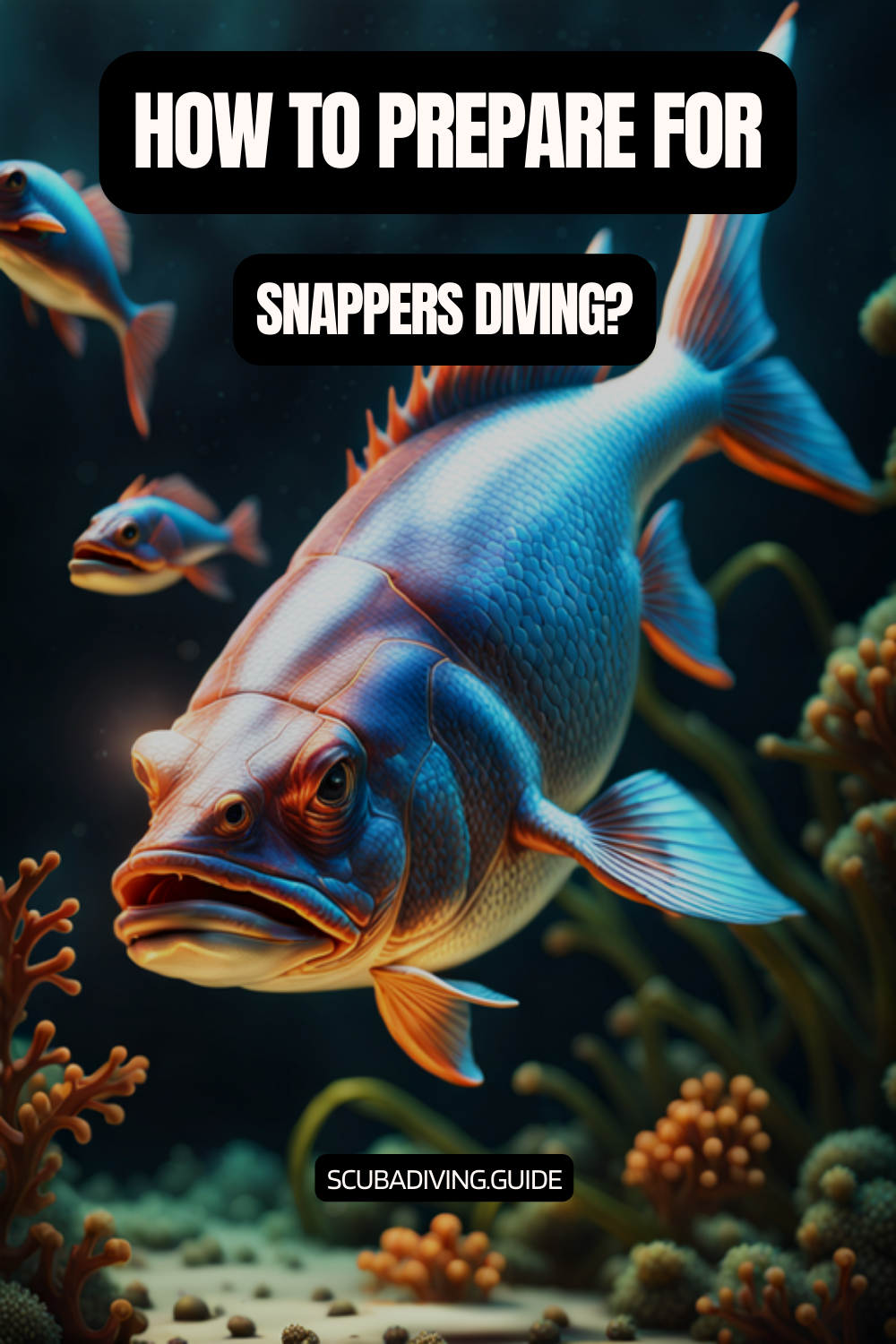
Recommended Diving Gear
For scuba diving with snappers, you’ll need a few important things:
- Mask: A low-volume design gives you the best view underwater
- Fins: Long-blade fins help you move easily and stay comfortable
- Wetsuit: Pick one that fits the water temperature (2mm for warm, 7mm for cold)
| Equipment Type | Key Features | Recommended Brand |
|---|---|---|
| BCD (Buoyancy Compensator Device) | Weight integration, comfort, safety | Scubapro Hydros Pro |
| Regulator | Environmental sealing, performance | Aqualung Legend |
| Dive Computer | Depth tracking, air integration | Suunto Zoop Novo |
Safety Equipment to Consider
When diving, safety is always first. You’ll need:
- Surface marker buoy (SMB) for visibility
- Dive knife for emergencies
- LED dive light with adjustable brightness
- Dive watch or timer to keep track of time
Pro tip: Always service your gear yearly and rinse it with fresh water after each dive. This keeps it working well and safe.
Remember, keeping your gear in good shape and checking it often is vital. It makes your scuba diving with snappers safe and unforgettable.
Scuba Diving Techniques for a Great Experience
Exploring the underwater world of snappers needs more than just excitement. You must learn precise techniques and understand how to interact with the marine environment.
Experts like Robin Aiello say mastering certain skills is key for a great dive. Sound travels faster underwater, so being aware and in control is vital for safety.
Best Practices for Diving with Snappers
Here are some important techniques for diving with snappers:
- Maintain slow, deliberate movements
- Practice excellent buoyancy control
- Monitor peripheral vision for marine life interactions
- Respect marine ecosystem boundaries
Maintaining Control Underwater
Staying safe while diving in snapper areas is essential. Focus on these important skills:
- Buoyancy Management: Precise control prevents reef damage
- Breathing Technique: Calm, steady breaths conserve energy
- Position Awareness: Minimize disruption to marine life
“Small reef areas can reveal extraordinary marine diversity within just one square meter.” – Marine Biology Research Team
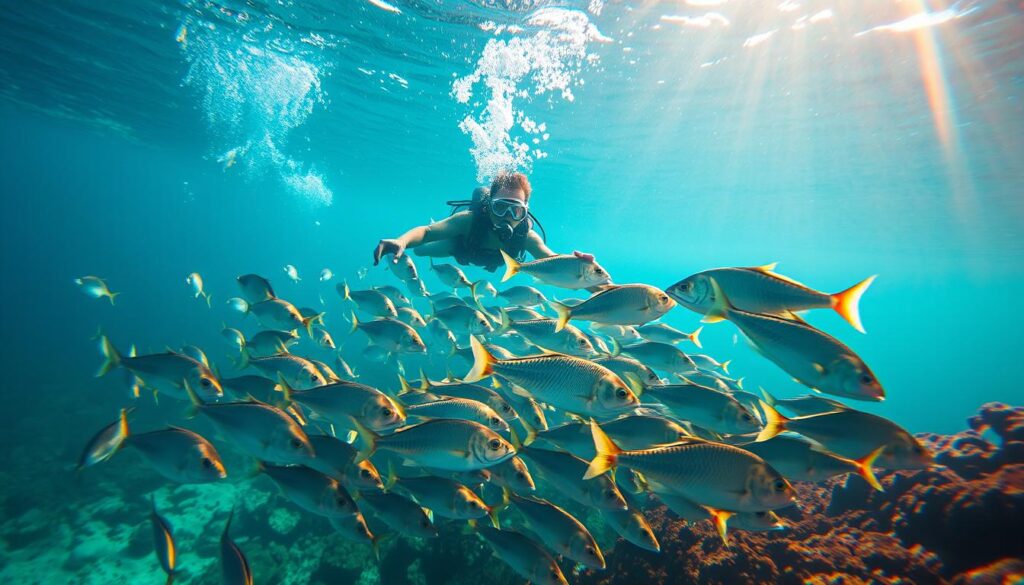
Knowing how marine life communicates and behaves helps divers. This way, they can enjoy amazing underwater encounters with snappers and other sea creatures without disturbing them.
Conservation Efforts for Snapper Populations
Protecting snapper fish species is a big job. We need to work together to save these amazing creatures. Their home, the ocean, is facing big problems that need quick and lasting solutions.
Keeping snapper populations healthy requires teamwork. Scientists and marine experts have come up with many ways to help these important sea animals.
Importance of Sustainable Diving
Good diving practices are key to saving snapper homes. Divers can help by being careful and respectful underwater.
- Minimize physical contact with marine environments
- Avoid disturbing natural snapper habitats
- Support marine protected areas
- Participate in citizen science projects
How Divers Can Help
Small actions can add up to big changes for snapper conservation. Knowing the problems these sea animals face is the first step to helping them.
| Conservation Strategy | Impact on Snapper Populations |
|---|---|
| Marine Protected Areas | Reduce overfishing by 40% |
| Fishing Regulations | Protect breeding populations |
| Citizen Science Monitoring | Track population health |
“Every dive is an opportunity to become a guardian of marine ecosystems.” – Marine Conservation Expert
The Gulf of Mexico Fishery Management Council has made big plans. They want to fully recover red snapper numbers by 2032. So far, their efforts are showing good results.
By diving responsibly and supporting conservation, divers can help a lot. They can protect snapper fish and ensure future generations can enjoy the ocean’s wonders.
Capturing the Experience: Photography Tips
Underwater photography turns diving into lasting memories. It’s for everyone, from beginners to pros. Capturing snappers needs special skills and gear.
Underwater photography is a way to tell stories with pictures. Snappers are a challenge but also a chance to show marine life.
Best Gear for Underwater Photography
Choosing the right gear is key for amazing photos. Here are some must-haves:
- Waterproof camera housing
- Wide-angle lens for reef scenes
- Macro lens for detailed fish shots
- Underwater strobes
- Color correction filters
Techniques for Stunning Snapper Shots
Learn these tips to get amazing snapper photos:
- Adjust white balance for depth
- Use natural light effectively
- Get close to subjects (within 1 meter)
- Apply rule of thirds composition
| Lens Type | Best Use | Recommended Depth |
|---|---|---|
| Fisheye (180 degrees) | Wide reef scenes | Shallow waters |
| Macro lens | Fish details | Close-up shots |
| 24mm lens | Portrait-style images | Mid-range depths |
“Underwater photography is about capturing the essence of marine life, not just recording images.” – Professional Underwater Photographer
Practice is key in underwater photography. Every dive is a chance to get better. You’ll create stunning visual narratives of snappers in their home.
Frequently Asked Questions about Scuba Diving with Snappers
New divers often wonder about exploring the sea with snappers. Knowing about scuba courses and safety tips is key. Our guide covers the main questions for those starting their snapper diving journey.
Common Concerns for Beginners
Safety is the biggest worry for new divers looking to meet snappers. It’s wise to take a course from PADI or similar groups. Dive centers also offer refresher courses for those who haven’t dived in a year, costing about $160 and including two dives.
Special Requirements for Snappers
Diving with snappers needs special care. Dive operators keep a 5:1 or 6:1 ratio of divers to guides. This ensures everyone gets the right attention and safety. Divers should be at least 10 years old and comfortable in water from 20 to 120 feet, based on their certification and the nitrox blend.
The Role of Dive Guides
Professional dive guides are essential for a great snapper diving trip. They share local knowledge, help find marine species, and keep everyone safe. Many guides also teach scuba courses. These courses improve your skills and confidence, making your dive both fun and educational.
Common Marine Species Found Alongside Snappers
Diving with snappers offers not only the thrill of encountering these vibrant fish but also the opportunity to observe a diverse array of marine life that coexists within their underwater habitats. From fascinating invertebrates to other colorful reef inhabitants, diving alongside snappers introduces divers to a rich and vibrant underwater ecosystem. Let’s explore some of the common marine species often found alongside snappers.
- Coral Reefs: Snappers are commonly associated with coral reefs, and diving among these vibrant ecosystems provides the opportunity to encounter a plethora of marine species. From the branching staghorn corals to the delicate sea fans and colorful soft corals, the reef itself is a breathtaking spectacle. Divers can observe a variety of fish, including angelfish, butterflyfish, parrotfish, and surgeonfish, darting in and out of the coral formations.
- Moray Eels: Moray eels, with their elongated bodies and menacing appearance, are frequent inhabitants of the reef. They often seek shelter within crevices and rocky outcrops, coexisting alongside snappers. Divers may encounter species such as the green moray eel, the spotted moray eel, or the elusive ribbon eel, each showcasing its unique markings and behavior.
- Lionfish: Lionfish, known for their vibrant stripes and striking venomous spines, are a common sight in the reefs where snappers reside. Although lionfish are considered an invasive species in some regions, their presence adds a touch of exotic beauty to the underwater landscape. Divers should exercise caution and maintain a respectful distance to avoid contact with their venomous spines.
- Reef Sharks: While diving with snappers, it is possible to encounter reef sharks such as the blacktip reef shark or the whitetip reef shark. These sleek predators are essential members of the reef ecosystem, playing a vital role in maintaining the balance of marine life. Observing these magnificent creatures gliding effortlessly through the water is an awe-inspiring experience.
- Turtles: Snappers often share their habitat with various species of sea turtles. Green turtles, hawksbill turtles, and loggerhead turtles are among the common turtle species encountered during dives. These gentle creatures gracefully navigate the reefs, occasionally surfacing for a breath of air. Observing their peaceful movements and observing their feeding or nesting behaviors is a memorable experience.
- Invertebrates: Alongside snappers, a diverse range of invertebrates adds splashes of color and unique patterns to the reef. This includes vibrant nudibranchs, crustaceans like shrimp and crabs, and delicate sea stars and sea cucumbers. Exploring the reef’s nooks and crannies reveals an intricate world of intricate invertebrate life that complements the presence of snappers.
- Schooling Fish: Besides snappers themselves, diving among these fish often offers the opportunity to witness other schooling species. Silvery baitfish like fusiliers or sardines may form massive, shimmering schools that move in unison, creating a mesmerizing spectacle. The interaction between these schools and the snapper schools adds a dynamic element to the underwater experience.
Encountering these common marine species alongside snappers provides divers with a deeper understanding of the interconnectedness and biodiversity of the underwater world. Each encounter is a reminder of the delicate balance that exists within these vibrant ecosystems and the importance of preserving them for future generations.
Remember, when interacting with these marine species, it’s crucial to respect their natural behavior, maintain a safe distance, and avoid disturbing their habitat. By doing so, divers can contribute to the conservation of these remarkable creatures and the preservation of their underwater home.
FAQ – Diving with Snappers
What are the most common snapper species I might encounter while diving?
You’ll see red snappers, yellowtail snappers, and cubera snappers underwater. Each is unique, with different sizes, colors, and where they live.
Do I need special certification to dive with snappers?
You don’t need a special snapper certification. But, an Open Water Diver certification is a good start. Advanced certifications might be needed for deeper dives where snappers are found.
What’s the best time of year to dive with snappers?
The best time to dive with snappers changes by location. In the Caribbean, dive from December to April for clear water. Indonesia offers diving all year, with the best visibility during the dry season.
How close can I get to snappers while diving?
Keep at least 3-5 feet away from snappers. This lets you observe and take photos without disturbing them.
What equipment do I need for photographing snappers underwater?
Use a waterproof camera, underwater housing, and strobe lights for snapper photos. Wide-angle and macro lenses are great for different views.
Are snappers dangerous to divers?
Snappers are not dangerous to divers. They’re curious but shy. If you approach too close, they’ll leave. Always be calm and respectful.
How can I contribute to snapper conservation?
Help snapper conservation by diving responsibly and joining marine programs. Avoid touching marine life and support protected areas. Join citizen science projects to monitor marine ecosystems.
What’s the best location for diving with snappers?
Dive in the Cayman Islands, Cozumel, Great Barrier Reef, or Raja Ampat. These places have clear water, diverse marine life, and lots of snappers.
Do I need special diving techniques for observing snappers?
Good buoyancy control is key. Move slowly and use proper finning to avoid disturbing snappers. This lets you observe them naturally.
What other marine life might I see alongside snappers?
You might see sea turtles, tropical fish, coral reef creatures, and predators like groupers or barracudas. Each dive spot has its own unique marine life.
